Wizardry Gaiden IV: Throb of the Demon’s Heart (ウィザードリィ・外伝IV~胎魔の鼓動~), released 9/20/1996, developed and published by ASCII
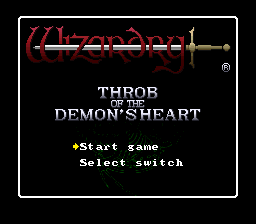
Wizardry is of course one of the ancestors of CRPGs, with 8 main games centered around so-called “blobber” dungeon exploring. At the time this game was released, the first seven main Wizardry titles were available in Japan both on computers and in a variety of console ports. In addition, three “gaiden” games had been released exclusively in Japan for the Game Boy. These followed faithfully in the pattern of the early Wizardry games. CRPGAddict played half of the first one, and his post is interesting for his view of this game coming from a fan of the western computer games (and someone who is decidedly not a fan of JRPGs). CRPGAddict also has a guest post covering the Japanese wizardry games in more detail.
Back in the day I finished the original Wizardry and I have played 5 and 6, though I never finished either of them. Gaiden IV is basically in the style of the first five games, although it borrows some of the races and classes (and magic types) from 6 with a few new things.

When you start you are immediately dropped into the town with no explanation; as you may be able to see this game uses a Japanese flavor rather than the usual medieval European fantasy of the Wizardry games. The game manual gives the backstory — basically there are three legendary objects that the new king hopes to use, to gain the power to put down a rebellion and bring peace to the kingdom. We are an adventuring party sent out to get the three objects.

You can use pre-generated characters but I took all their gear and sold it for money and deleted them, and made my own party. All of the classes from the original Wizardry are there — the Priest, Thief, Fighter, and Mage for basic classes, and the Lord (fighter + priest), Bishop (mage + priest), Samurai, and Ninja for prestige classes. They also added psionic and alchemy spells and new hybrid classes to take advantage of them. The races are the W6 races (so the classic ones plus Rawulf, Mook, Faerie, etc).
As in the classic games you roll a random value for points to add to your base stats. Normally you get 10 or less, but rarely you will get above that (up to 30 max). In the original games it was beneficial to spend a long time rerolling so that you could start with better stats and also be able to access the prestige/hybrid classes early. It’s not necessary to do that in this game because if you get 10 or fewer points, you start at level 4. This not only gives you 3 levels of stat boosts but also lets you start with more HP, which is a big help surviving at the beginning.
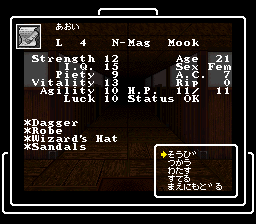
My party (which I named after Tale of Genji characters) was two fighters, two priests, a ranger (who can do Thief stuff), and a mage. My intention was to class up later to a Lord, Valkyrie, and Monk, and I wasn’t sure what to do with the extra priest and mage. (In the end, I ended up leaving the priest as is, and turning the Mage into a Valkyrie after she learned her last level of spells.) Everyone starts with a basic set of equipment but I bought some additional things with my money.
The interface is a big problem, I think. It’s based on the computer games, which are marginally better because you can use the keyboard to directly select items and people. Even there it can be frustrating, but when you have to use a controller to select everything, it’s really annoying to have individual gold, for instance. Also the fact that every item you find in the dungeon needs to be identified is troublesome because you either need to transfer all the items to a bishop, or pay quite a bit of money to have it done in town. Then a big failing of the game is that there is no way to see what the stats of equipment is; I found a list of weapons/armor by googling but it was still frustrating to figure out if the new equipment I had gotten was any good.
The healing is also done via the classic method where you either pay a bunch of money to rest in the inn, or use priest spells, going in and out of the dungeon until everyone is at full.
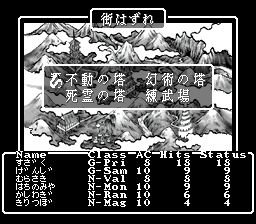
Each of the three objects you need is in one of three dungeons. I’m not sure why they set it up the way they did — once you recover one of the objects, the other two dungeons have almost all their NPCs and puzzles removed, but you still have to go through them to get the objects. I think maybe the reason they did this is that the monsters are of similar difficulty in each dungeon, so perhaps they didn’t want you to have to spend a lot of time with easy monsters once you had cleared one place? Even so you have to explore the other dungeons so I’m not sure what the point was. The fourth choice there is a “training dungeon” where you can go just to fight things; there’s also an opaque sidequest involving that dungeon that can unlock the strongest monster in the game.
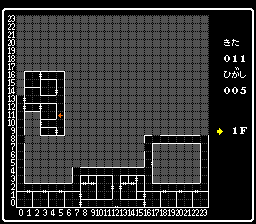
At this point you just make excursions into the dungeon. As in classic Wizardry games, the majority of the dungeon is empty and so you’re mostly just mapping things out looking for the few events you need to do to progress. Your resources are quite limited and you have no “warp back to town” spell so you need to be quite careful in your excursions — this provided most of the tension and I suppose enjoyment of classic Wizardry.
This game is easier in two ways than the original. First, there is an automap, although you can only see the 3×3 square around you unless you cast the Dumapic spell. The second is that unless you play it on “mania mode”, you can reset your game during a fight and you will start before the fight. In classic Wizardry, you never “save” your game; if your party dies, their corpses remain in the dungeon and you have to get another party to go in and find them. You also are not guaranteed to be able to raise dead characters and can lose them permanently. I think a lot of players (myself included) made disk backups to lessen the sting — it was too time consuming to do the backups constantly, but it was better than losing your whole party.

The battle system is classic Wizardry, although weapons have a range — I’m not sure when (if) this was added to the core Wizardry games. Your characters in 4-6 position can only attack if they have weapons with long enough range to reach the enemies. Otherwise they just have to defend or cast spells. Same is true for the enemies, of course.
In the first tower, you basically find a number of keys and other objects that open up doors and let you explore the entire tower. One part you have to get a dude to drop you into a pit so you can explore the lower levels.
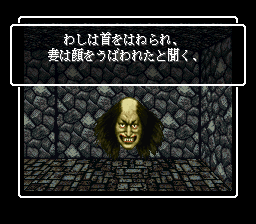
There are multiple solutions to each dungeon — you can kill the NPCs to get their items, or you can take “peaceful” solutions, some of which require items from the other dungeons. As far as I can tell there is no gameplay benefit to the peaceful solutions and you actually lose XP for doing them.
Once you get the three items, the lord goes to defeat the rebels, but then an unnamed lord suddenly awakes a different evil and you have a new dungeon to explore.
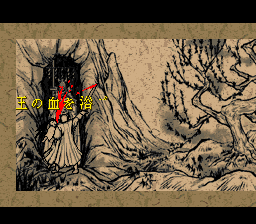
The first 4 levels of this dungeon are copies of the Wizardry 1 (proving grounds) dungeons, but after that, the B5-7 dungeons have a complicated puzzle where you have to press buttons to get statues onto the bottom floor. I used a walkthrough to solve this.
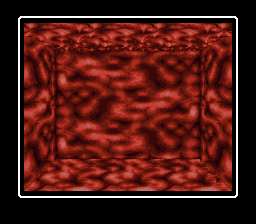
Beyond this, you get the last dungeon level, which is an embryo-like place (the “taima” of the title is really “demon embryo” rather than “heart”). This is where I stopped playing — you have to beat 7 or 8 very difficult encounters to reach the final boss. I got ten game overs on the first encounter, did some grinding, and decided it was going to take way too long to finish it. There is a translation patch so anyone can try it themselves.
As I understand, after you beat the boss there are two additional post-game dungeons, in addition to the superboss in the training dungeon, so there’s quite a bit of content in the game. I think that if you like the classic Wizardry format and don’t mind the interface issues, you will enjoy this game a lot.
As a final note, the Wizardry wiki has the title misspelled as 大麻の鼓動 “Throb of the marijuana”.
The title says “(Part 1)”, but this does not read as if a part 2 will still follow – or will it?
No, sorry. I created the post when I thought I might not be able to do the game in one week. I’ll change it now.